Go to the main page
This page describes and explains the reactions between complex ions of the type [M(H2O)6]n+ and hydroxide ions from, for example, sodium hydroxide solution.
It assumes that you know why these ions are acidic, and are happy about the equilibria involved. | |
Important: If you aren't happy about the acidity of the hexaaqua ions, it is essential that you follow this link before you go any further. | |
|
The general caseAlthough there are only minor differences, for simplicity we will look at 2+ ions and 3+ ions separately. Adding hydroxide ions to 2+ hexaaqua ions These have the form [M(H2O)6]2+. Their acidity is shown in the reaction of the hexaaqua ions with water molecules from the solution: They are acting as acids by donating hydrogen ions to water molecules in the solution. Because of the confusing presence of water from two different sources (the ligands and the solution), it is easier to simplify this: Disturbing this equilibrium by adding hydroxide ions - stage 1 What happens if you add hydroxide ions to this equilibrium? There are two possible reactions. Reaction of hydroxide ions with the hydroxonium ions (hydrogen ions) According to Le Chatelier's Principle, the position of equilibrium will move to the right, producing more of the new complex ion. 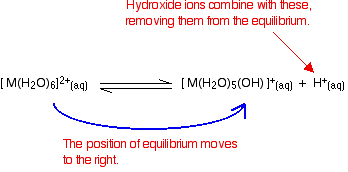 | |
Note: You really need to know about Le Chatelier's Principle, particularly with regard to the effect of changes in concentration on the position of equilibrium. Follow this link if you aren't sure.Use the BACK button on your browser to return quickly to this page. | |
| Reaction of hydroxide ions with the hexaaqua ion Statistically, there is far more chance of a hydroxide ion hitting a hexaaqua metal ion than of hitting a hydrogen ion. There are far more hexaaqua ions present. If that happens, you get exactly the same new complex ion formed as above. Notice that this isn't a ligand exchange reaction. The hydroxide ion has removed a hydrogen ion from one of the ligand water molecules. The reaction has also become virtually one-way. The second stage of the reaction Whichever of the above reactions happens, you end up with [M(H2O)5(OH)]+ ions in solution. These are also acidic, and can lose hydrogen ions from another of the water ligands. Taking the easier version of the equilibrium: Adding hydroxide ions again tips the equilibrium to the right - either by reacting with the hydrogen ions, or by reacting directly with the complex on the left-hand side. When this happens, the new complex formed no longer has a charge - we describe it as a "neutral complex". In all the cases we are looking at, this neutral complex is insoluble in water - and so a precipitate is formed. This precipitate is often written without including the remaining water ligands. In other words we write it as M(OH)2. A precipitate of the metal hydroxide has been formed. | |
Note: Which version of the formula for the metal hydroxide should you write? The full version, [M(H2O)4(OH)2], shows more clearly what is going on. Be guided by what your examiners prefer. It may actually vary depending on what context the compound crops up in. My preference is for the full version, and that's what I shall use throughout. | |
Summarising what has happened so far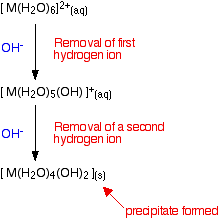 There is no logical reason why the removal of hydrogen ions from the complex should stop at this point. Further hydrogen ions can be removed by hydroxide ions to produce anionic complexes - complexes carrying negative charges. Whether this actually happens in the test tube to any extent varies from metal to metal. 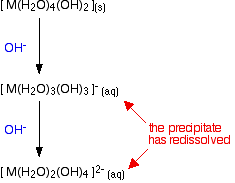 Adding hydroxide ions to 3+ hexaaqua ions The argument here is exactly as before - the only difference is the number of hydrogen ions which have to be removed from the original hexaaqua complex to produce the neutral complex. Going beyond the neutal complex is also rather more common with 3+ than with 2+ ions, and may go as far as having a hydrogen ion removed from each of the six water molecules. This is summarised in the same sort of flow scheme as before: 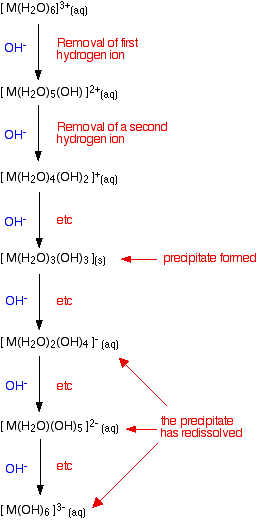 | |
Note: | |
|
Looking at the ions of specific metalsIn each case the formula of the precipitate will be given as if it were the simple neutral complex. In fact, these "hydroxide" precipitates sometimes rearrange by losing water from combinations of the attached OH groups. This produces oxides closely associated with the lost water. These changes are beyond the scope of this site. 2+ ions hexaaquacobalt(II) 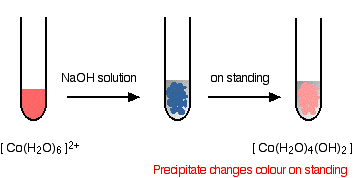 | |
Note: | |
hexaaquacopper(II)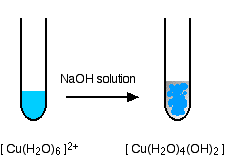 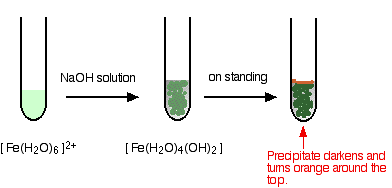 hexaaquamanganese(II) 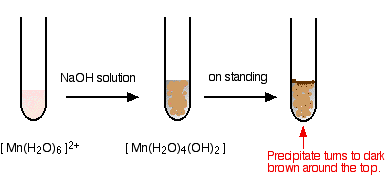 hexaaquanickel(II) 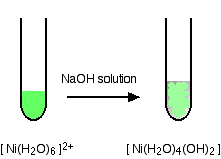 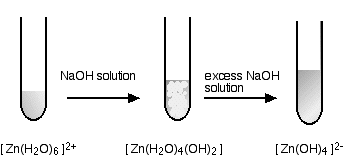 3+ ions hexaaquaaluminium  hexaaquachromium(III) 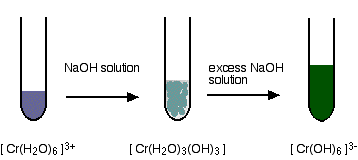 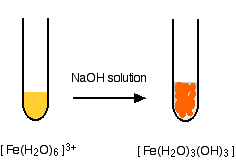 | |
Note: The original colour of the iron(III) ion is very variable - from a pale yellow to a darkish orange-brown. None of these colours is actually the colour of the true hexaaquairon(III) ion. This is explored in more detail on the page about the acidity of the hexaaqua ions. | |
|
Reversing the processIf adding hydroxide ions removes hydrogen ions from the hexaaqua complex one at a time, it doesn't seem unreasonable that you could put them back again by adding an acid. That's just what happens! We'll look in detail at what happens in the chromium(III) case, but exactly the same principle applies to all the other examples we've looked at - whether for 2+ or 3+ ions. As long as you understand what is happening, you can work out the details if you need to. Adding acid to hexahydroxochromate(III) ions These are the ions formed at the end of the sequence in which you add hydroxide ions to a solution containing hexaaquachromium(III) ions. Their formula is [Cr(OH)6]3-. | |
Note: If you are bothered about the name of these ions: "hexa" = 6; "hydroxo" = OH groups; "chromate(III)" = chromium in the +3 oxidation state, but in a negative ion. If you need to explore these names in more detail, you could look at the page on naming, but it isn't very important for the present topic. | |
A reminder of the colour changes when you add sodium hydroxide solution to a solution containing hexaaquachromium(III) ions: 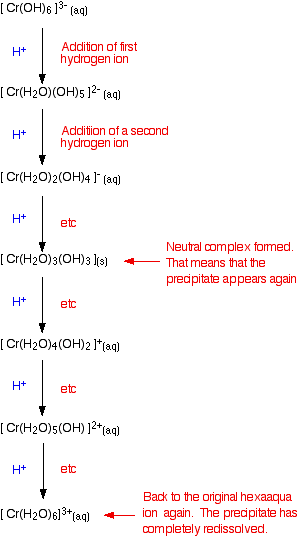 You can apply this to any case. If you know the colours as you remove hydrogen ions, you automatically know them as you put the hydrogen ions back on again. It also doesn't matter where you start from either - whether, for example, you add acid to an ionic complex like [Cr(OH)6]3-, or a neutral one like [Fe(H2O)4(OH)2]. You will know that the [Fe(H2O)4(OH)2] is a dirty green precipitate. When you add the hydrogen ions back to it, it will revert to the very pale green solution of the [Fe(H2O)6]2+ ion. None of this is a new bit of learning - you just have to re-arrange what you already know! | |
Note: In fact, in the chromium case, it is actually slightly more difficult than this, because the final solution tends to end up green rather than the usual strange blue-grey-violet of the hexaaquachromium(III) ion.This happens whenever you produce hexaaquachromium(III) ions in a test tube. The problem is that other ions from the solution (chloride or sulphate) replace one or more water molecules in the complex and give green colours. This is explored some more in the page on ligand exchange reactions | |
Amphoteric hydroxidesAn amphoteric substance has both acidic and basic properties. In other words, it will react with both bases and acids. Some of the metal hydroxides we've been looking at are doing exactly that. Chromium(III) hydroxide as an amphoteric hydroxide "Chromium(III) hydroxide" is a simple way of naming the neutral complex [Cr(H2O)3(OH)3]. You have seen that it reacts with bases (hydroxide ions) to give [Cr(OH)6]3-. It also reacts with acids (hydrogen ions) to give [Cr(H2O)6]3+. This is a good example of amphoteric behaviour. Other examples of amphoteric hydroxides are zinc hydroxide and aluminium hydroxide. Quite a lot of metal hydroxides won't react any further with hydroxide ions if you use sodium hydroxide solution at the sort of concentrations normally used in the lab. That means that they don't have any significant acidic nature. "Copper(II) hydroxide" is what we would normally call the neutral complex [Cu(H2O)4(OH)2]. This doesn't dissolve in sodium hydroxide solution at any concentration normally used in the lab. It doesn't show any acidic character. On the other hand, it will react with acids - replacing the lost hydrogen ions on the water ligands. Because it is accepting hydrogen ions, it is acting as a base. Hydroxides like this (which react with acids, but not bases) are notamphoteric - they are just simple bases. | |
No comments:
Post a Comment